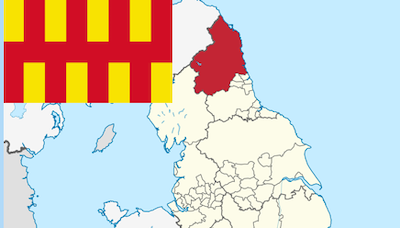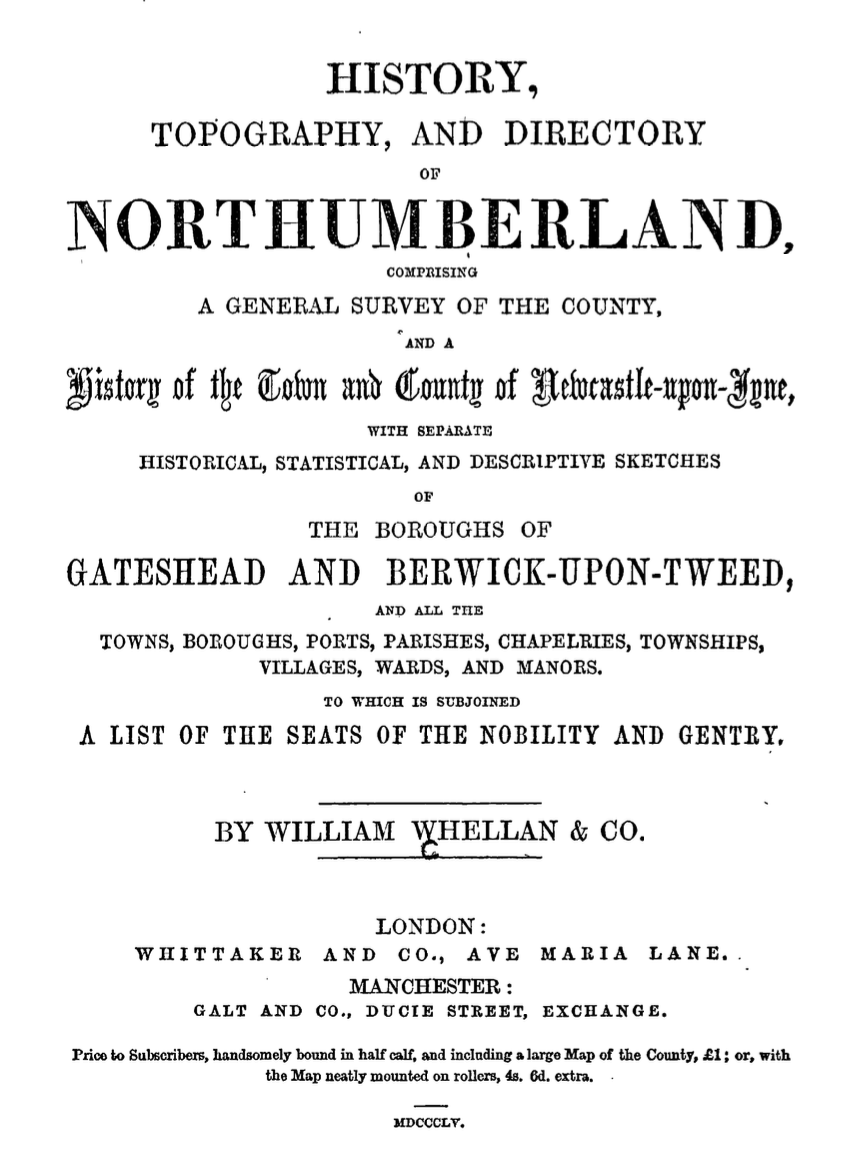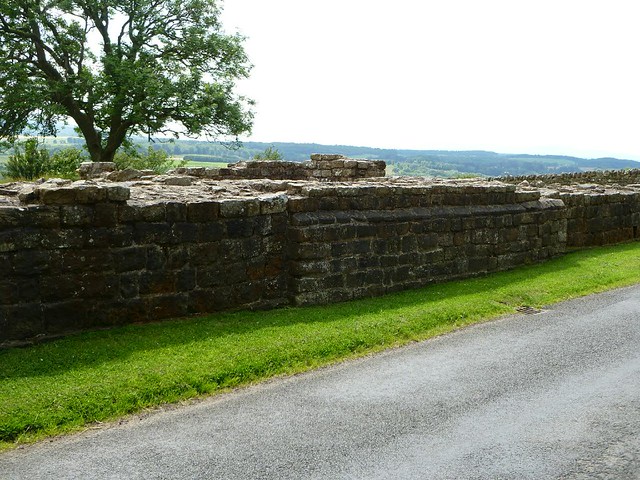Topics > Northumberland > Civil Parishes in Northumberland > Alnwick Town Council area > Alnwick Parish, 1855 > Institutions, Alnwick Parish, 1855
Institutions, Alnwick Parish, 1855
Extract from: History, Topography, and Directory of Northumberland...Whellan, William, & Co, 1855.
CHURCHES, CHAPELS, PUBLIC INSTITUTIONS, &c.
THE PARISH CHURCH of Alnwick is dedicated to the Blessed Virgin and St. Michael the Archangel. It is an ancient structure, situated to the north west of the town, at the end of Bailiffgate. The date of its erection cannot be ascertained, though from the architecture of the arches, and from the arms if the Vesci family being on different parts, and the arms of Percy on, one of the caps of the pillars, it is supposed to have been built about the year 1300. It contains few monuments of any importance. On repairing the north aisle in 1816, two statues were found, one of them represents a person, with his hands and feet bound, and his body transfixed with arrows; this is supposed to be a statue of St. Sebastian. The other is apparently the figure of a king, having a crown on his head, a ball and sceptre in his hands, and a purse at his girdle. It is not known what personage this is intended to represent. In the chancel is the recumbent figure of a female, who appears to have belonged to some religious order. The surcoat, helmet and gloves, and the funeral achievements, of the Dukes of Northumberland hang against the wall This church has been frequently repaired, but much of its original character still remains. There was formerly a chantry in this church, dedicated to our Lady, which was founded by Henry, Earl of Northumberland, in the reign of Henry VI. Its revenues were augmented, from time to time by grants from pious individuals, and seems to have risen rapidly, as it only listed for 100 years. At the Dissolution it possessed forty-four burgages in various parts of the town of Alnwick, containing in all eleven acres. As the forty-four burgages only produced a rental of £12 13s. 4d. in 1547, They must have been chiefly small cottages, and small properties, which, after the suppression of the religious houses, were granted to several individuals. The living is a perpetual curacy in the archdeaconry of Lindisfarne and Deanery of Alnwick, rated in the Liber Regis at £15; and in the parliamentary returns at £106. The endowments are £800 private benefactions, £200 royal bounty, and £2,100 parliamentary grant; gross income, £175. Patron, the Duke of Northumberland. Incumbent, the Rev. Court Granville, M.A.; curate, Rev. Henry Miles, B.A.
ST. PAUL’S CHURCH, situated in the Green Bat, is a neat structure in the early English style of architecture, erected in 1847. Rev. Charles Charlton, M.A., incumbent.
ST. MARY's CATHOLIC CHURCH is situated in Bailiffgate. It is a neat edifice, and has long been served by priests of the Society of Jesus. Rev. Sidney Woollett, S.J., priest.
CHAPELS. THE BETHEL CHAPEL, in Chapel-street, belongs to the Methodist New Connexion, and has a small library attached to it. The INDEPENDENT CHAPEL, situated in St. Michael's-lane, was erected in 1816, but the congregation has existed since 1731. THE PRESBYTERIAN MEETING HOUSE, in Pottergate, was rebuilt in 1780, by a congregation which had existed from a period anterior to the Revolution of 1688. Rev, John Walker, minister. THE UNITARIANS have a small chapel in Correction House Yard, in which they have assembled since 1817. There is also the UNITED PRESBYTERIAN CHAPEL, Clayport-street, the Rev. William Leamont, minister; the UNITED PRESBYTARIAN CHAPEL, Lisburn-street, Rev. William Donaldson, minister; and the WESLEYAN METHODIST CHAPEL, Old Chapel-lane, Rev. James Dunbar, minister.
SCHOOLS. THE BOROUGH SCHOOLS are situated in Dispensary-street, and were established for-the education of the freemen's children of the borough. The Grammar School, which forms a portion of this establishment, is endowed principally from the corn-tolls, granted in 1649, by Algernon, Earl of Northumberland. This income, which has considerably decreased of late years, is augmented by a voluntary gift from the corporation, and all sons of freemen who apply are taught classics free. The master is also allowed to take pay scholars. George Meaby, B.A., head master. ST. MARY'S CATHOLIC SSHOOL is situated in Howick-street, James Cronin and Rosetta Palmer; teachers. THE BRITISH SCHOOL is in Bondgate, John Elleathrope, teacher. ALNWICK NATIONAL SCHOOLS are situated in Pottergate, Robert W. Irving and Margaret lrving, teachers. THE DlJKE'S SCHOOL, in the Green Bat, was erected and founded foe 200 poor boys by the Duke of Northumberland in 1810, and the DUCHESS’ SCHOOL in Canongate was instituted by the Duchess of Northumberland, for clothing and educating 10 poor girls. Besides these there are several private and Sunday Schools, which are numerously attended.
THE TOWN HALL, is situated on the west side of the Market-place in the centre of the town. It was erected in 1731, and contains a large hall with two rooms adjoining, and is used for holding the quarter sessions, the manor and county courts, and the meetings of the common council and the several companies of freemen. In this hall the members of parliament for the county are elected, and other public business is transacted.
THE CORRECTION HOUSE AND JUSTICES' ROOM is situated in the vicinity of the Market-place. It was erected in 1807, and contains workrooms, cells, and other necessary apartments, with two separate yards for the prisoners. There is also a large room, in which the justices of the peace meet regularly once a fortnight to transact business. John Nichol, keeper, Isabell Nichol, matron.
THE DISPENSARY, established in 1815, is in Dispensary-street, and is under the management of two physicians, two surgeons, and an apothecary, whose offices occupy the ground floor. The upper story contains two wards, one for each sex and a fever-ward, with an apartment for the matron, and chambers for the nurses. Upwards of 400 patients receive medical and surgical assistance at this institution annually. Every subscriber of one guinea or upwards per annum, is considered a governor, with the privilege of voting in all the transactions of the charity, and may have one patient constantly on the books. Edward Smiles, house surgeon.
THE GAS WORKS are in Canongate, and was established in 1825, for the manufacture of oil-gas, but were converted into coal-gas works in 1830. The quantity of gas made in the year is estimated at 1,802,402 feet, for which the charge to the public is eight shillings per 1,000 cubic feet. On the first establishment of the company the price was twenty shillings per 1,000 feet.
THE POST OFFICE is situated in Fenkle-street. George Tate, Esq., F.G.S., postmaster. The REGISTRAR'S AND GUARDIANS' OFFICES are in the Market- place. A SAVINGS BANK was established here in 1816 and is situated in St. Michael's-lane. THE STAMP OFFICE is in Bailiffgate, Henry Alder, distributor.
THE ALNWICK SCIENTIFIC AND MECHANICAL INSITUTION was established in 1824; and, since that period, it has continued to receive that attention and support from the learned and wealthy, which it so justly merits. It possesses a good library; and the other conveniences of a successful institution. Patron, the Duke of Northumberland; president, Earl Grey, secretaries, George Tate, Esq., F.G.S., and Mr. Thomas Buddle.
THE ALNWICK POOR LAW UNION comprehends seventy-one parlshes and townships, embracing an area of 98,935 statute acres, and its population in 1851 was 21,122 souls. The parishes and townships are Abberwick, Abbey Lands, Acklington, Acklington Park, Acton and Old Felton, Alnmouth, Alnwick, Alnwick South Side, Amble, Bassington, Beanley, Bilton, Birling, Bolton, Boulmer and Seaton House, Broome Park, Brotherwick, Broxfield, Brunton, Buston High, Buston Low, Canongate, Charlton North, Charlton South, Craster, Crawley, Denwick, Ditchburn, Doxford, Dunston, Edlingham, Eglingham, Elyhaugh, Embleton, Fallodon, Felton, Glanton, Gloster Hlll, Greens and Glantlees, Guyzance, Harehope, Hauxley, Hawkhill, Hazon and Hartlaw, Hedgeley, Howick, Hulne Park, Learchild, Lemmington, Lesbury, Little Houghton, Long Houghton, Morwick, Newton-by-the·Sea, Newton-on-the-Moor, Rennington, Rock, Shawdon, Shieldykes, Shilbottle, Shipley, Stamford, Sturton Grange, Swarland, Titlington, Togstone, Walkmill, Warkworth, Whittle, Wooden, and Woodhouse.
THE UNION WORKHOUSE is situated in Bondgate Without. The Board of Guardians meet on the second and last Saturday of each month. William Dickson. Esq., chairman.. Rev. Court Granville, chaplain ; John Davidson, surgeon; John Johnson, master; Ann Johnson, matron; Henry and Elizabeth Masters, teachers; and George Nicholson, porter.
BRISLEE TOWER occupies an elevated situation about two miles to the north-west of the castle, and commands a most extensive view of the surrounding country. The design of the tower is very elegant, and it is finished in the highest style of masonry. Above the entrance, on the first balcony is the following inscription: MDCCLXXXI. H. DVX. NORTHUMBRIE FECIT. A little above the balcony, under a medallion of the duke, is inscribed the following ; CIRCUMSPICE. EGO OMNIA ISTRUM DIMENSUS; MEI SUNT ORDINES, MEA DESCRIPTIO, MULTA ETIAM ISTARUM ARBORUM MEA MANUSUNT SATE. Which may be rendered. "Look around you. I have measured out all these things ; they are my orders, it is my planning, many of these trees have even been planted by my hand.'' .
A circular internal staircase leads to the summit, which is sixty-six feet high, and is surrounded with a balcony, and above all, a curious iron grate finishes this column whose total height is ninety feet. The uppermost balcony commands an extensive and varied prospect. To the west lies the fertile vale of Whittingham, to the north-west the hills of Cheviot, to the east are fine green vales, in the midst of which the town of Alnwick, overlooked by the castle, has a most picturesque appearance, and to the. south the ruins of the ancient castle of Dunstanbrough, the towering remains of Warkworth Castle, and the high land in the county of Durham, terminate the prospect.
THE PERCY TENANTRY COLUMN is situated on a beautiful knoll adjoining the road on the southern entrance to the town. It stands upon a base upwards of ninety feet in circumference, built with a species of rose coloured granite. This basement is ascended by steps in four divisions, separated by huge plinths, on which are placed colossal lions raised on bases of polished black marble. From this basement another elevation rises, which finishes with a gallery, having its angles ornamented by Etruscan plasters, and the sides formed into square panels, that facing the east contains the following inscription :- TO HUGH, DUKE OF NORTHUMBERLAND; K.G. THIS COUMN IS ERECTED, DEDICATED, AND INSCRIBED, BY A GRATEFUL AND UNITED TENANTRY, ANNO DOMINI MDCCCXVI.
In each of the four panels of the parapet of the gallery is engraved the armorial motto of the Percy family: ESPERANCE EN DIEU. Out of this gallery the column rises, resting on a squared plinth. The capital of the column forms a light veranda, secured by an elegant iron palisade, and from this veranda a circular pedestal arises, supporting a lion passant, the crest of the house of Percy.
BOROUGH OF ALNWICK. Alnwick claims to be a borough by prescription, The archives do not contain any royal incorporating charter, but an established corporation is recognised by a charter of 42, Henry III The officers of the corporation are four chamberlains, twenty-four common councilmen, and chamberlain's clerk. The corporate name is "The Chamberlain's Common Council, and Freemen of the Borough of Alnwick". They exercise no jurisdiction over the affairs of the town, but they are possessed of some property in land and houses, out of the income of which they support a school for their own children, and they maintain several public pants, and two public clocks. The freemen originally consisted of several guilds, or companies, at present reduced to ten, viz.: the cordwainers, the skinners and glovers, the merchants, the tanners, the weavers, the blacksmiths, the butchers, the joiners, the tailors, and the coopers. Each company is governed by an alderman, wardens, and stewards, who are appointed annually, and has peculiar bye-laws and orders for its own regulation. The freemen of Alnwick, on their. admission to their rights on St Mark's day, have to pass through a pool on the moor, the water of which is purposely made fithy and muddy; hidden stakes, pitfalls, and obstructions are also placed in the water, and through this foul pool, so prepared, laughed at, pelted, and hooted by his townsmen, each young freeman is required to pass before he can take up his freedom. After this agreeable bath he has to ride the bounds of the moor on horseback; over about twelve miles of most dangerous road, which is attempted at a racing pace for the honour of precedence given to the person who accomplishes the distance first, and, as some of the young men know little of horsemanship, serious accidents have taken place. Tradition assigning this custom to a capricious mandate of King John, who had been befouled in the filth of Ayden Forest, when hunting. That which was imposed as a penance is now performed as an honour, but it is time that this memento of a weak- minded tyrant should be terminated, and that a more rational mode of taking up their freedom and preserving the boundaries of their property should be adopted by the freemen. The county magistrates hold a monthly court at Alnwick for the east division of Coquetdale ward.
CHARITIES. Mark Forster, by his will, bearing date 20th September, 1726, left a rent charge of £15 per annum; £10 for the education of the children of poor freemen, and widows of freemen of the borough of Alnwick, and the remaining £5. to be distributed amongst the poor of the town and parish of Alnwick. Hugh Potter, in 1669, bequeathed £40 to the town of Alnwick, the interest at the rate of six per cent, to be distributed to the poor on Good Friday. Benjamin Barton, by his will, dated 18th December, 1737, gave £100 to the minister of Alnwick, in trust, that the interest of £50 should be distributed among the common poor of the said town and the interest of the other £50 paid for the education of "unfreemen's'' children of the said town. Mary Taylor, in 1807, gave to the churchwardens and overseers of the poor of the parish of Alnwick, £100, clear of all duty, upon trust, to place out the same and distribute the interest yearly at Christmas, among the poor persons residing in the said parish; and Stanton Neale, by his will, proved at Durham, in 1814, gave to the curate and churchwardens of Alnwick, for the time being, an annuity of £10 to be distributed among the poor of the township of Alnwick on Christmas Day.










